NVIDIA GeForce GTX 760 Review: The New Enthusiast Kepler
by Ryan Smith on June 25, 2013 9:00 AM ESTPower, Temperature, & Noise
As always, last but not least is our look at power, temperature, and noise. Next to price and performance of course, these are some of the most important aspects of a GPU, due in large part to the impact of noise. All things considered, a loud card is undesirable unless there’s a sufficiently good reason – or sufficiently good performance – to ignore the noise.
With both the 600 series GK104 parts and the GK104 based GTX 770 as a backdrop here, we’re not expecting any great surprises here. Power consumption is going to approach the GTX 670 thanks to GPU Boost 2.0 and the identical TDPs. And since the cooler is also the same, acoustics should also be similar. Only idle power should show any real variation.
| GeForce GTX 760 Voltages | ||||
| GTX 770 Max Boost | GTX 760 Max Boost | GTX 770 Idle | ||
| 1.2v | 1.2v | 0.850v | ||
Like the GTX 770, GTX 760 is spec’d to a stock top voltage of 1.2v. This buys NVIDIA the 1100MHz+ clockspeeds we’re seeing, but it drives up power consumption.
| GeForce GTX 760 Average Clockspeeds | |||
| Max Boost Clock | 1149MHz | ||
| DiRT:S |
1134MHz
|
||
| Shogun 2 |
1127MHz
|
||
| Hitman |
1149MHz
|
||
| Sleeping Dogs |
1139MHz
|
||
| Crysis |
1145MHz
|
||
| Far Cry 3 |
1132MHz
|
||
| Battlefield 3 |
1123MHz
|
||
| Civilization V |
1139MHz
|
||
| Bioshock Infinite |
1131MHz
|
||
| Crysis 3 |
1105MHz
|
||
Looking at the average clockspeeds among our games, despite the official 1033MHz boost clock for GTX 760 always boosts to an average over 1100MHz, with most games boosting to around 1130MHz. The limiting factor here is typically temperatures, which quickly hit 80C at the highest boost bin and its 1.2v operating voltage. A card with a better cooler would likely have no trouble sustaining 1149MHz here.
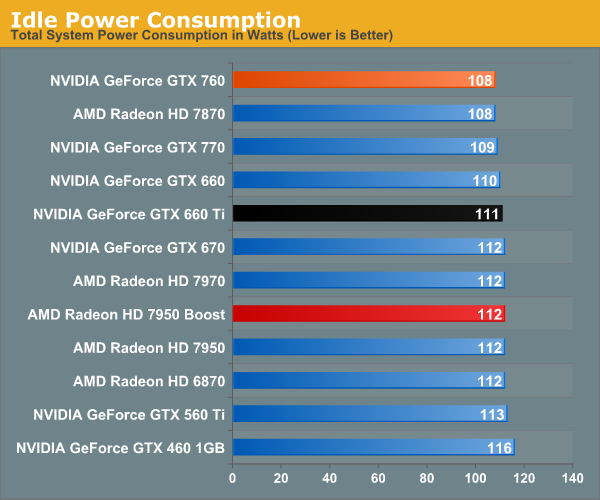
As we saw with the GTX 770 a few weeks ago, NVIDIA’s idle power consumption as measured at the wall has come down a couple of watts compared to the older GK104 cards. With a lower idle clockspeed compared to the GTX 660 Ti and its ilk, NVIDIA has been able to shave off that wattage without any more substaintial changes. However I continue to be surprised that we’re seeing any difference between the GTX 760 and the 7950B, as AMD is no slouch here either.
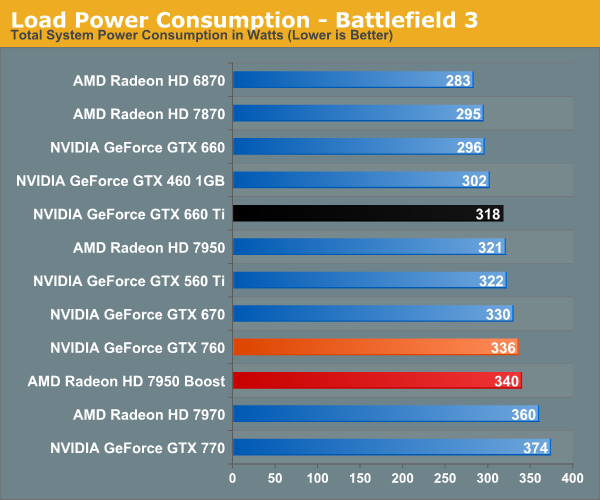
Moving on to load power under Battlefield 3, our results validate our earlier theories on power consumption based on the spec sheets. Wall power with a GTX 760 is 6W higher than GTX 670 in this test, and 18W higher than with a GTX 660 Ti. There’s no getting around the fact that GTX 670-like performance requires GTX 670-like power consumption.
At the same time the power consumption of the GTX 760 is almost identical to the 7950B at the wall. Though given the 7950B’s lower performance in this benchmark, what we’re actually seeing is lower CPU power consumption offsetting the 7950B’s higher power consumption.
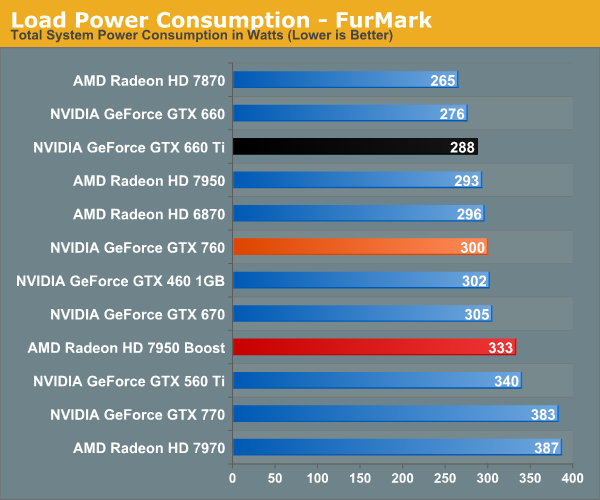
With Furmark the story is fairly similar for the NVIDIA cards, all of which come close together due to their similar TDPs. Meanwhile the 7950B pulls about 30W more at the wall, in-line with its 200W TDP. NVIDIA edged out AMD on power efficiency with the 600 series, and we’re going to see the same thing on the 700 series.
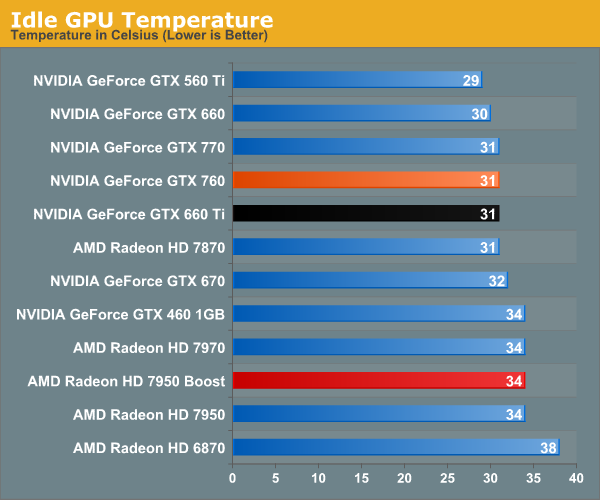
Based on the same cooler and GPU as the GTX 670, the GTX 760 offers no grand revelations here. 31C is standard for this type of blower cooler.
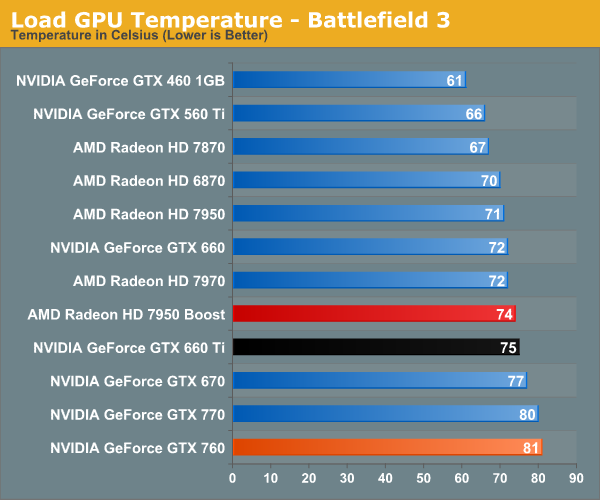
Even though the GTX 760 and GTX 670 have identical TDPs, the presence of GPU Boost 2.0 means that the GTX 760 operates nearer its TDP more often, and in this case the 80C throttle imposed by GPU Boost makes itself felt. 81C does end up being the worst among the cards in this collection, but it’s a reasonable temperature for a GK104 GPU, to the point where in temperature limited scenarios this is exactly where it’s designed to top out at.

With FurMark our results are much the same as with BF3. The slower response time of the fans on the GTX 770 and GTX 760 mean that both cards top out at 82C before temperatures level out, a few degrees warmer than with the GTX 670 and GTX 660 Ti. Alternatively the 7950B and its more powerful fan keep temperatures at or below 75C for any workload we throw at it.
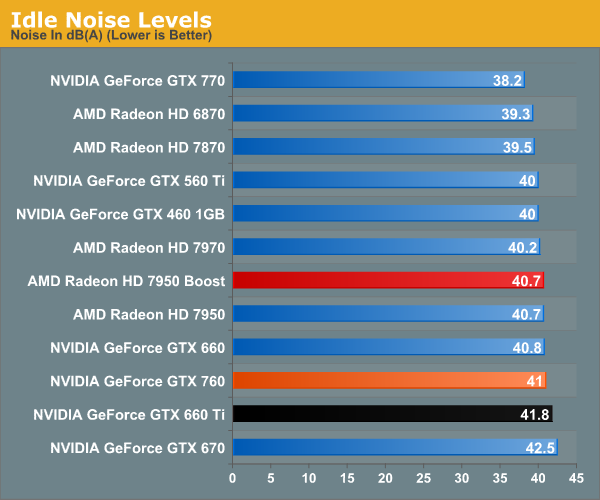
Since NVIDIA used the same cooler/fan assembly as on the GTX 670, the GTX 760 is going to give us similar acoustics. Unfortunately that includes the characteristic faint grinding noise that we’re previously mentioned. Idle noises as a result are respectable, but GTX 770 this is not.

Moving to fan noise under load, here we can see NVIDIA’s default fan curve and 80C throttle once again pay off. The GTX 760 hits 50dB under BF3, which for this specific cooler is actually doing a bit better than average, as evidenced by the slight advantage the GTX 760 has over the GTX 670. The GTX 770 and Fermi cards are something of spoilers here though, a reminder of what the Titan cooler and open air cooling can do. We will have some custom GTX 760s next week, so it will be interesting to see how much better these cards are when it comes to noise. 50dB is by no means bad, especially for the performance, but at this point we’ve seen lower noise levels out of cards with similar price tags and TDPs.
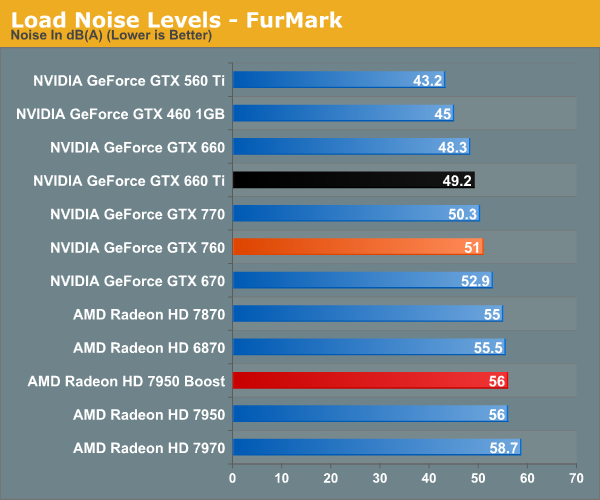
Finally, FurMark once again paints a picture very similar to what we saw with Battlefield 3. For NVIDIA cards this is middle of the road, while at 5dB quieter than the reference 7950B it’s a significant improvement.










110 Comments
View All Comments
YukaKun - Tuesday, June 25, 2013 - link
And where's my beloved GTX670?! Are you guys hiding something here that nVidia doesn't want me to see?No, but really; I know it's not it's direct replacement, but I'd really like to see the numbers how they stack up.
Cheers!
Ryan Smith - Tuesday, June 25, 2013 - link
The GTX 670 is in all of our charts. All of this data is also on Bench.YukaKun - Tuesday, June 25, 2013 - link
Yeah, just realized it is... I wonder why I didn't see it, lol.Selective reading at its finest indeed.
Thanks Ryan!
HisDivineOrder - Tuesday, June 25, 2013 - link
AMD is now saying the Never Settle Reloaded bundle is running out at retailers. That means, you should be mentioning that it isn't going to last much longer and doesn't really factor into the value of the 7950/7950B unless they decide to renew it.I suspect though they'll do a price drop soon.
DanNeely - Tuesday, June 25, 2013 - link
I'd expect them to create a new bundle instead.kallogan - Tuesday, June 25, 2013 - link
Too big, barely better than 660 ti at higher power consumption. What's the point ?MrSpadge - Tuesday, June 25, 2013 - link
Too big: there will loads of custom coolers, just like on the current cards. Shorter ones as well.barely better than 660 ti at higher power consumption: the additional performance is approximately proportional to the added power draw, so efficiency hardly suffers. Of course I'll stick with my OC'ed 660Ti, but this newcomer is just more balanced for everything but the most pure compute tasks.
What's the point: cheaper for nVidia to produce (one SMX less) and sold cheaper. It's a win-win.
jimwatkins - Tuesday, June 25, 2013 - link
I suppose this is of little interest to most readers, but since your doing computer performance, how about a bitcoin GH performance chart. Video cards are actually of waning value in the bitcoin arms race but it's an interesting aspect of compute performance nonetheless and the high end AMD cards certainly still produce value.dcianf - Tuesday, June 25, 2013 - link
I'm excited to see them maintain compatibility with my 660Ti/670 full card waterblock. PLEASE LET THIS BE A NEW STANDARD!JimmiG - Tuesday, June 25, 2013 - link
Well it's hotter, more power hungry and louder than the GTX 670 while still being slower, which is kind of disappointing for something that's supposed to be an evolution of the GTX 600 series. Still, it does feel like "GTX 660 Done Right" in some ways, as that card was always too slow, forcing people to pay $400 for the GTX 670.It's sad that prices have been creeping up so much without people noticing. $499 used to be the "ultra-enthusiast" segment, and $199 would buy you a very decent card. In 2012 and early 2013, $400 was the "mid-range" and $999 the "ultra high-end". GTX 760 brings the mid-range back to $250 again, at least until the GTX 860 come out at $499...